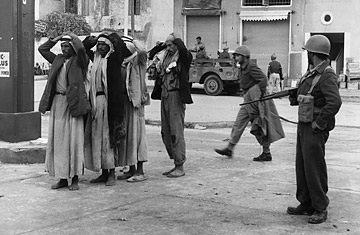
Israeli troops stop Arabs for questioning in the Gaza Strip in 1956.
The region of Gaza, a 25-mile long, 7-mile wide finger of land along the Mediterranean at the border between Israel and Egypt, has been at the center of geopolitical tug-of-wars for its entire existence. Originally part of the Ancient Egyptian region of Canaan, Gaza was best known in ancient times for its strategic location as an important trading center for Asian, European and North African markets. The desirability of the territory resulted in frequent battles for its control. Gaza was conquered by the Philistines in the 13th century B.C., razed by the Hasmonean Kingdom and suffered incursions from the likes of Napoleon and Alexander the Great, whose army put the entire male population to death for refusing to surrender. (See pictures of the conflict in the Gaza Strip.)
Gaza's longest modern stretch of occupation came after the region fell to the Ottoman Empire in 1517, under whose sway it remained for four centuries, until the dissolution of the Empire following World War 1. After World War II, a massive influx of Jews to the British Mandate of Palestine and the partitioning of the territory into separate Jewish and Arab states led to the 1948 Arab-Israeli War. The subsequent 1949 Armistice Agreement gave Jordan control over the West Bank region of Palestine while Egypt gained control of Gaza.
Gaza became densely populated with Arab refugees expelled from the newly independent Israel. While in the West Bank, Jordan offered citizenship to many of the refugees, Egypt did not extend the offer to Gazans; they remained under Egyptian military rule until Israel reoccupied the strip following the 6-day war against the Arab States in 1967. Gaza and the West Bank remained under Israeli occupation and military control for nearly 30 years, during which the Palestinians of the region struggled achieve independence while clashing with Jewish settlers encroaching into Palestinian territories.
The first organized Palestinian uprising or "intifada" against Israeli rule came from a refugee camp in northern Gaza in 1987 and quickly spread across the region. During the revolt, which brought international attention to the Palestinian cause, the political party known as Hamas was created as a Palestinian extension of the popular Muslim Brotherhood Organization that had already swept through Egypt and much of the Arab world. Hamas gained momentum in the occupied region, especially in Gaza, by establishing educational and social programs for disenfranchised Palestinians, but drew international condemnation for its tactics of rebellion against Israel, including terror attacks and suicide bombings. Hamas continued to denounce Israel's presence in the region, demanding a Palestinian Islamic state in its place. Hamas' militancy strained the 1993 Oslo Accords, brokered between Israel and the Palestinian Liberation Organization, which relinquished control of parts of occupied Gaza and the West Bank to a semi-autonomous government, the Palestinian Authority, in exchange for an agreement to stem the violence. The Palestinian Authority's inability to halt attacks from groups like Hamas and its mismanagement of the occupied areas, combined with Israel's refusal to dismantle the remaining settlements, fractured the accord and led to a second Palestinian Intifada in 2000. Israeli withdrawal of forces and settlements in Gaza came only in 2005, after which Hamas increased their influence in the strip, edging out rival group Fatah, a more secular offshoot of the Palestinian Authority led by President Mahmoud Abbas.
Hamas' popularity was cemented in the 2006 parlimentary elections in the volatile region, when it won 74 out of 132 seats in a result that shocked Israeli and Western observers. Fatah's refusal to relinquish control following the election forced an explosive week-long showdown between western-backed Fatah forces and Hamas; the infighting culminated the expulsion of Fatah security forces from Gaza and a de facto divide of the territory controlled by the Palestinian Authority between the Hamas-governed Gaza Strip and the West Bank, which remained under Fatah control.
Following the battle, Israel imposed a blockade on Gaza in an attempt to strangle the strip's economy and undermine Hamas' abilty to govern. Human rights groups say the blockade, which prevents Gazans from leaving and goods and aid from entering, has caused a serious humanitarian crisis in the area. Hamas has responded to the siege by regularly raining rockets into southern Israeli towns from Gaza. Despite mutual agreement in June 2008 to a 6-month ceasefire, Israel continued their blockade of Gaza and Hamas responded with sporadic mortar hits. After the expiration of the truce on December 19, a surge of Hamas rocket attacks that wounded one Israeli caused the country to step up the blockage. Finally, on December 26, just over a week later, Israeli forces began a massive bombardment of Gaza that has so far left close to 700 Palestinians and five Israelis dead.
